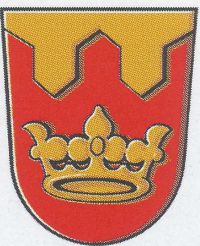Großsorheim: Difference between revisions
Jump to navigation
Jump to search
Knorrepoes (talk | contribs) m (Text replacement - "{{media}} Literature : " to "Literature : {{media}} ") |
Knorrepoes (talk | contribs) m (Text replacement - "Literature :" to "'''Literature''':") |
||
| Line 23: | Line 23: | ||
The crown refers to the fact that in early medieval times the area was part of a Royal Estate. Later the area belonged to the Lords (later Counts) of Oettingen. The vair is taken from the oldest arms of the Lords of Oettingen. | The crown refers to the fact that in early medieval times the area was part of a Royal Estate. Later the area belonged to the Lords (later Counts) of Oettingen. The vair is taken from the oldest arms of the Lords of Oettingen. | ||
[[Civic Heraldry Literature - Germany|Literature]] : | [[Civic Heraldry Literature - Germany|'''Literature''']]: | ||
{{media}} | {{media}} | ||
Revision as of 09:04, 9 September 2022
This page is part of the German heraldry portal Deutsche Wappensammlung |
Heraldry of the World |
|
German heraldry:
|
Selected collector's items from Germany:
|
GROSSSORHEIM
State : Bayern
District (Kreis) : Donau-Ries (until 1973 Donauwörth)
Incorporated into : 1976 Harburg
| German |
Unter einem Schildhaupt in der Form von zwei gestürzten goldenen Eisenhüten in Rot eine goldene Laubkrone. |
| English | No blazon/translation known. Please click here to send your (heraldic !) blazon or translation |
Origin/meaning
The crown refers to the fact that in early medieval times the area was part of a Royal Estate. Later the area belonged to the Lords (later Counts) of Oettingen. The vair is taken from the oldest arms of the Lords of Oettingen.
Contact and Support
Partners:
Your logo here ?
Contact us
© since 1995, Heraldry of the World, Ralf Hartemink 
Index of the site
![]()












